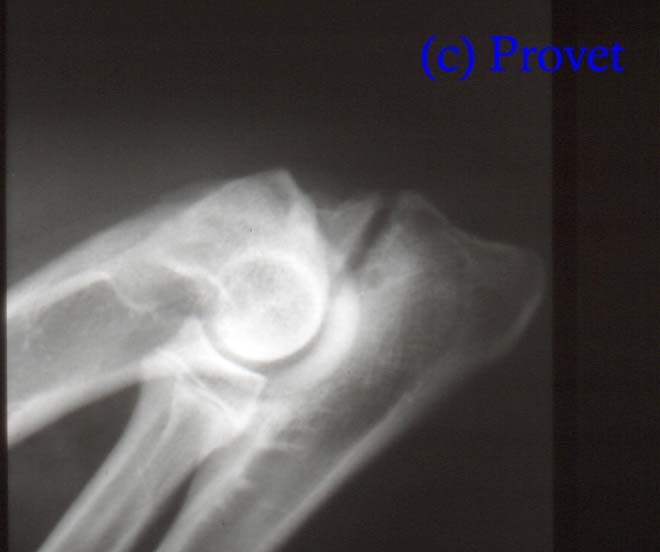 Back
Back
|
ELBOW DYSPLASIA
Note for Pet Owners: Topics on this Page:
|
Description
Elbow dysplasia means abnormal development of the elbow joint. In dogs there are
several developmental abnormalities which can occur and which form part of this
disease syndrome including :
- Osteochondritis dissecans (OCD)
- Ununited anconeal process
- Ununited (or fragmented) coronoid process
Cause
However, because there is likely to be a genetic influence affected dogs should not be bred from and owners of affected breeds are encouraged to submit their animals to the screening programme being run, in the UK, by the British Veterinary Association and the Kennel Club.
Contact your veterinarian for further information , or write to Provet at info@provet.co.uk
Other possible causes are trauma to the elbow, and other developmental problems.
Breed Occurrence
Elbow dysplasia usually affects large and giant breeds of dog and , in it's
various forms, has an increased incidence in the Afghan, Bernese Mountain Dog,
Bullmastiff, French Bulldog, German Shepherd Dog, Great Dane, Irish Wolfhound,
Labrador Retriever, Pointer, Pyrenean Mountain Dog, St Bernard and Weimeraner.
It has also been reported in achondroplastic breeds - the Bassett Hound and the
Dachshund.
Signs
- Some dogs have elbow dysplasia but show no clinical signs
- Abnormal posture - the elbow may be held out away form the body
- Abnormal gait - the foreleg may be thrown out away from the body during walking/running, and the dog may take short stilted steps.
- Stiffness - the dog may walk with a stiff, jerky action in the affected foreleg(s)
- Limited range of movement - the range of movement in the elbow joints may be greatly reduced.
- Pain - the dog may yelp when it uses the leg
- Swelling of the joint - as secondary changes occur in the elbow, soft tissue swelling and new bone deposition around the joint will increase it's size.
- Reluctance to exercise - especially if the elbow(s) is(are) painful
Complications
Diagnosis
Diagnosis is confirmed by the clinical signs, pain on flexion and extension of
the elbows and on radiography:

Ununited Anconeal Process (triangular bone fragment)
.JPG)
Coronoid Disease
Treatment
Treatment depends upon the primary cause of the disease :
- Surgery to remove or fix in place an ununited anconeal process
- Surgery to remove bone and cartilage fragments in fragmented coronoid process
- Surgery to remove bone and cartilage fragments in osteochondrosis dissecans
- Analgesics - to reduce pain
- Anti-inflammatory drugs - to reduce the inflammatory reaction going on in the joint
- Reduce body weight if the animal is overwieght/obese
- Controlled exercise - avoid excessive exercise
Prognosis
Most cases will progress to develop secondary osteoarthitis
Long term problems
Updated October 2013